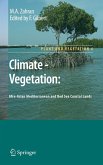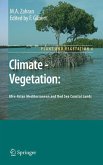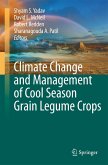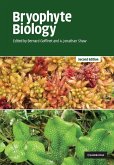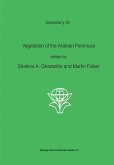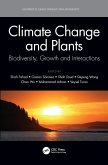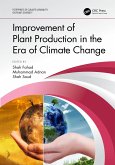Bryophyte Ecology and Climate Change
Herausgeber: Tuba, Zoltán; Stark, Lloyd R; Slack, Nancy G
Bryophyte Ecology and Climate Change
Herausgeber: Tuba, Zoltán; Stark, Lloyd R; Slack, Nancy G
- Gebundenes Buch
- Merkliste
- Auf die Merkliste
- Bewerten Bewerten
- Teilen
- Produkt teilen
- Produkterinnerung
- Produkterinnerung
Explores how mosses can be used as monitors and experimental subjects for present and future climate change.
Andere Kunden interessierten sich auch für
![Climate - Vegetation: Climate - Vegetation:]() M.A. ZahranClimate - Vegetation:147,99 €
M.A. ZahranClimate - Vegetation:147,99 €![Climate - Vegetation: Climate - Vegetation:]() M.A. ZahranClimate - Vegetation:147,99 €
M.A. ZahranClimate - Vegetation:147,99 €![Climate Change and Management of Cool Season Grain Legume Crops Climate Change and Management of Cool Season Grain Legume Crops]() Shyam Singh Yadav / David L. McNeil / Robert et al. Redden (Hrsg.)Climate Change and Management of Cool Season Grain Legume Crops147,99 €
Shyam Singh Yadav / David L. McNeil / Robert et al. Redden (Hrsg.)Climate Change and Management of Cool Season Grain Legume Crops147,99 €![Bryophyte Biology Bryophyte Biology]() Bernard GoffinetBryophyte Biology85,99 €
Bernard GoffinetBryophyte Biology85,99 €![Vegetation of the Arabian Peninsula Vegetation of the Arabian Peninsula]() GhazanfarVegetation of the Arabian Peninsula191,99 €
GhazanfarVegetation of the Arabian Peninsula191,99 €![Climate Change and Plants Climate Change and Plants]() Climate Change and Plants230,99 €
Climate Change and Plants230,99 €![Improvement of Plant Production in the Era of Climate Change Improvement of Plant Production in the Era of Climate Change]() Improvement of Plant Production in the Era of Climate Change223,99 €
Improvement of Plant Production in the Era of Climate Change223,99 €-
-
-
Explores how mosses can be used as monitors and experimental subjects for present and future climate change.
Hinweis: Dieser Artikel kann nur an eine deutsche Lieferadresse ausgeliefert werden.
Hinweis: Dieser Artikel kann nur an eine deutsche Lieferadresse ausgeliefert werden.
Produktdetails
- Produktdetails
- Verlag: Cambridge University Press
- Seitenzahl: 528
- Erscheinungstermin: 14. Februar 2011
- Englisch
- Abmessung: 249mm x 175mm x 28mm
- Gewicht: 1157g
- ISBN-13: 9780521767637
- ISBN-10: 0521767636
- Artikelnr.: 31891166
- Herstellerkennzeichnung
- Produktsicherheitsverantwortliche/r
- Europaallee 1
- 36244 Bad Hersfeld
- gpsr@libri.de
- Verlag: Cambridge University Press
- Seitenzahl: 528
- Erscheinungstermin: 14. Februar 2011
- Englisch
- Abmessung: 249mm x 175mm x 28mm
- Gewicht: 1157g
- ISBN-13: 9780521767637
- ISBN-10: 0521767636
- Artikelnr.: 31891166
- Herstellerkennzeichnung
- Produktsicherheitsverantwortliche/r
- Europaallee 1
- 36244 Bad Hersfeld
- gpsr@libri.de
List of contributors; Preface; Part I. Introductory Chapters: 1. The
ecological value of bryophytes as indicators of climate change Nancy G.
Slack; 2. Bryophyte physiological processes in a changing climate: an
overview Zoltán Tuba; Part II. Ecophysiology: 3. Climatic responses and
limits of bryophytes: comparisons and contrasts with vascular plants
Michael C. F. Proctor; 4. Effects of elevated air CO2 on bryophytes: a
review Zoltán Tuba, Edit Ötvös and Ildikó Jócsák; 5. Seasonal and
interannual variability of light and UV acclimation in mosses Niina M.
Lappalainen, Anna Hyyryläinen and Satu Huttunen; Part III. Aquatic
Bryophytes: 6. Ecological and physiological effects of changing climate on
aquatic bryophytes Janice Glime; 7. Aquatic bryophytes under ultraviolet
radiation Javier Martinez-Abaigar and Encarnación Núñez-Oliver; Part IV.
Desert and Tropical Ecosystems: 8. Responses of a biological crust moss to
increased monsoon precipitation and nitrogen deposition in the Mojave
desert Lloyd R. Stark, D. Nicholas McLetchie, Stanley D. Smith and Melvin
J. Oliver; 9. Ecology of bryophytes in Mojave desert biological soil
crusts: effects of elevated CO2 on sex expression, stress tolerance, and
productivity in the moss Syntrichia caninervis Mitt. John C. Brinda,
Catherine Fernando and Lloyd R. Stark; 10. Responses of epiphytic bryophyte
communities to simulated climate change in the tropics Jorge Jácome, S.
Robbert Gradstein and Michael Kessler; Part V. Alpine, Arctic, and
Antarctic Ecosystems: 11. Effects of climate change on tundra bryophytes
Annika K. Jägerbrand, Robert G. Björk, Terry Callaghan and Rod Seppelt; 12.
Alpine bryophytes as indicators for climate change: a case study from the
Austrian Alps Daniela Hohenwallner, Harold G. Zechmeister, Dietmar Moserm,
Harald Pauli, Michael Gottfried, Karl Reiter and Georg Grabherr; 13.
Bryophytes and lichens in a changing climate: an Antarctic perspective Rod
D. Seppelt; Part VI. Sphagnum and Peatlands: 14. Living on the edge: the
effects of drought on Canada's western boreal peatlands Melanie Vile,
Kimberli D. Scott, Erin Brault, R. Kellman Wieder and Dale H. Vitt; 15. The
structure and functional features of sphagnum cover of the northern west
Siberian mires in connection with forecasting global environmental and
climatic changes Aleksei V. Naumov and Natalia P. Kosykh; 16. The
southernmost sphagnum-dominated mires on the plains of Europe: formation,
secondary succession, degradation and protection Janos Nagy; Part VII.
Changes in Bryophyte Distribution with Climate Change: Data and Models: 17.
The role of bryophyte paleoecology in quaternary climate reconstructions
Gusztáv Jakab and Pál Sümegi; 18. Signs of climate change in the bryoflora
of Hungary Tamás Pócs; 19. Can the effects of climate change on British
bryophytes be distinguished from those resulting from other environmental
changes? Jeffrey W. Bates and Christopher D. Preston; 20. Climate change
and protected areas: how well do our rare bryophytes fare? Barbara J.
Anderson and Ralf Ohlemuller; 21. Modeling the distribution of
Sematophyllum substrumulosum (Hampe) E. Britton as a signal of climatic
changes in Europe Cecília Sérgio, Rui Figueira and Rui Menezes; 22.
Modelling bryophyte productivity across gradients of water availability
using canopy form-function relationships Steven Rice, Nathali Neal, Jesse
Mango and Kelly Black; Part VIII. Conclusions: 23. Bryophytes as predictors
of greenhouse gas enrichment and current climate change L. Dennis Gignac;
24. Conclusions Nancy G. Slack and Lloyd R. Stark; Index.
ecological value of bryophytes as indicators of climate change Nancy G.
Slack; 2. Bryophyte physiological processes in a changing climate: an
overview Zoltán Tuba; Part II. Ecophysiology: 3. Climatic responses and
limits of bryophytes: comparisons and contrasts with vascular plants
Michael C. F. Proctor; 4. Effects of elevated air CO2 on bryophytes: a
review Zoltán Tuba, Edit Ötvös and Ildikó Jócsák; 5. Seasonal and
interannual variability of light and UV acclimation in mosses Niina M.
Lappalainen, Anna Hyyryläinen and Satu Huttunen; Part III. Aquatic
Bryophytes: 6. Ecological and physiological effects of changing climate on
aquatic bryophytes Janice Glime; 7. Aquatic bryophytes under ultraviolet
radiation Javier Martinez-Abaigar and Encarnación Núñez-Oliver; Part IV.
Desert and Tropical Ecosystems: 8. Responses of a biological crust moss to
increased monsoon precipitation and nitrogen deposition in the Mojave
desert Lloyd R. Stark, D. Nicholas McLetchie, Stanley D. Smith and Melvin
J. Oliver; 9. Ecology of bryophytes in Mojave desert biological soil
crusts: effects of elevated CO2 on sex expression, stress tolerance, and
productivity in the moss Syntrichia caninervis Mitt. John C. Brinda,
Catherine Fernando and Lloyd R. Stark; 10. Responses of epiphytic bryophyte
communities to simulated climate change in the tropics Jorge Jácome, S.
Robbert Gradstein and Michael Kessler; Part V. Alpine, Arctic, and
Antarctic Ecosystems: 11. Effects of climate change on tundra bryophytes
Annika K. Jägerbrand, Robert G. Björk, Terry Callaghan and Rod Seppelt; 12.
Alpine bryophytes as indicators for climate change: a case study from the
Austrian Alps Daniela Hohenwallner, Harold G. Zechmeister, Dietmar Moserm,
Harald Pauli, Michael Gottfried, Karl Reiter and Georg Grabherr; 13.
Bryophytes and lichens in a changing climate: an Antarctic perspective Rod
D. Seppelt; Part VI. Sphagnum and Peatlands: 14. Living on the edge: the
effects of drought on Canada's western boreal peatlands Melanie Vile,
Kimberli D. Scott, Erin Brault, R. Kellman Wieder and Dale H. Vitt; 15. The
structure and functional features of sphagnum cover of the northern west
Siberian mires in connection with forecasting global environmental and
climatic changes Aleksei V. Naumov and Natalia P. Kosykh; 16. The
southernmost sphagnum-dominated mires on the plains of Europe: formation,
secondary succession, degradation and protection Janos Nagy; Part VII.
Changes in Bryophyte Distribution with Climate Change: Data and Models: 17.
The role of bryophyte paleoecology in quaternary climate reconstructions
Gusztáv Jakab and Pál Sümegi; 18. Signs of climate change in the bryoflora
of Hungary Tamás Pócs; 19. Can the effects of climate change on British
bryophytes be distinguished from those resulting from other environmental
changes? Jeffrey W. Bates and Christopher D. Preston; 20. Climate change
and protected areas: how well do our rare bryophytes fare? Barbara J.
Anderson and Ralf Ohlemuller; 21. Modeling the distribution of
Sematophyllum substrumulosum (Hampe) E. Britton as a signal of climatic
changes in Europe Cecília Sérgio, Rui Figueira and Rui Menezes; 22.
Modelling bryophyte productivity across gradients of water availability
using canopy form-function relationships Steven Rice, Nathali Neal, Jesse
Mango and Kelly Black; Part VIII. Conclusions: 23. Bryophytes as predictors
of greenhouse gas enrichment and current climate change L. Dennis Gignac;
24. Conclusions Nancy G. Slack and Lloyd R. Stark; Index.
List of contributors; Preface; Part I. Introductory Chapters: 1. The
ecological value of bryophytes as indicators of climate change Nancy G.
Slack; 2. Bryophyte physiological processes in a changing climate: an
overview Zoltán Tuba; Part II. Ecophysiology: 3. Climatic responses and
limits of bryophytes: comparisons and contrasts with vascular plants
Michael C. F. Proctor; 4. Effects of elevated air CO2 on bryophytes: a
review Zoltán Tuba, Edit Ötvös and Ildikó Jócsák; 5. Seasonal and
interannual variability of light and UV acclimation in mosses Niina M.
Lappalainen, Anna Hyyryläinen and Satu Huttunen; Part III. Aquatic
Bryophytes: 6. Ecological and physiological effects of changing climate on
aquatic bryophytes Janice Glime; 7. Aquatic bryophytes under ultraviolet
radiation Javier Martinez-Abaigar and Encarnación Núñez-Oliver; Part IV.
Desert and Tropical Ecosystems: 8. Responses of a biological crust moss to
increased monsoon precipitation and nitrogen deposition in the Mojave
desert Lloyd R. Stark, D. Nicholas McLetchie, Stanley D. Smith and Melvin
J. Oliver; 9. Ecology of bryophytes in Mojave desert biological soil
crusts: effects of elevated CO2 on sex expression, stress tolerance, and
productivity in the moss Syntrichia caninervis Mitt. John C. Brinda,
Catherine Fernando and Lloyd R. Stark; 10. Responses of epiphytic bryophyte
communities to simulated climate change in the tropics Jorge Jácome, S.
Robbert Gradstein and Michael Kessler; Part V. Alpine, Arctic, and
Antarctic Ecosystems: 11. Effects of climate change on tundra bryophytes
Annika K. Jägerbrand, Robert G. Björk, Terry Callaghan and Rod Seppelt; 12.
Alpine bryophytes as indicators for climate change: a case study from the
Austrian Alps Daniela Hohenwallner, Harold G. Zechmeister, Dietmar Moserm,
Harald Pauli, Michael Gottfried, Karl Reiter and Georg Grabherr; 13.
Bryophytes and lichens in a changing climate: an Antarctic perspective Rod
D. Seppelt; Part VI. Sphagnum and Peatlands: 14. Living on the edge: the
effects of drought on Canada's western boreal peatlands Melanie Vile,
Kimberli D. Scott, Erin Brault, R. Kellman Wieder and Dale H. Vitt; 15. The
structure and functional features of sphagnum cover of the northern west
Siberian mires in connection with forecasting global environmental and
climatic changes Aleksei V. Naumov and Natalia P. Kosykh; 16. The
southernmost sphagnum-dominated mires on the plains of Europe: formation,
secondary succession, degradation and protection Janos Nagy; Part VII.
Changes in Bryophyte Distribution with Climate Change: Data and Models: 17.
The role of bryophyte paleoecology in quaternary climate reconstructions
Gusztáv Jakab and Pál Sümegi; 18. Signs of climate change in the bryoflora
of Hungary Tamás Pócs; 19. Can the effects of climate change on British
bryophytes be distinguished from those resulting from other environmental
changes? Jeffrey W. Bates and Christopher D. Preston; 20. Climate change
and protected areas: how well do our rare bryophytes fare? Barbara J.
Anderson and Ralf Ohlemuller; 21. Modeling the distribution of
Sematophyllum substrumulosum (Hampe) E. Britton as a signal of climatic
changes in Europe Cecília Sérgio, Rui Figueira and Rui Menezes; 22.
Modelling bryophyte productivity across gradients of water availability
using canopy form-function relationships Steven Rice, Nathali Neal, Jesse
Mango and Kelly Black; Part VIII. Conclusions: 23. Bryophytes as predictors
of greenhouse gas enrichment and current climate change L. Dennis Gignac;
24. Conclusions Nancy G. Slack and Lloyd R. Stark; Index.
ecological value of bryophytes as indicators of climate change Nancy G.
Slack; 2. Bryophyte physiological processes in a changing climate: an
overview Zoltán Tuba; Part II. Ecophysiology: 3. Climatic responses and
limits of bryophytes: comparisons and contrasts with vascular plants
Michael C. F. Proctor; 4. Effects of elevated air CO2 on bryophytes: a
review Zoltán Tuba, Edit Ötvös and Ildikó Jócsák; 5. Seasonal and
interannual variability of light and UV acclimation in mosses Niina M.
Lappalainen, Anna Hyyryläinen and Satu Huttunen; Part III. Aquatic
Bryophytes: 6. Ecological and physiological effects of changing climate on
aquatic bryophytes Janice Glime; 7. Aquatic bryophytes under ultraviolet
radiation Javier Martinez-Abaigar and Encarnación Núñez-Oliver; Part IV.
Desert and Tropical Ecosystems: 8. Responses of a biological crust moss to
increased monsoon precipitation and nitrogen deposition in the Mojave
desert Lloyd R. Stark, D. Nicholas McLetchie, Stanley D. Smith and Melvin
J. Oliver; 9. Ecology of bryophytes in Mojave desert biological soil
crusts: effects of elevated CO2 on sex expression, stress tolerance, and
productivity in the moss Syntrichia caninervis Mitt. John C. Brinda,
Catherine Fernando and Lloyd R. Stark; 10. Responses of epiphytic bryophyte
communities to simulated climate change in the tropics Jorge Jácome, S.
Robbert Gradstein and Michael Kessler; Part V. Alpine, Arctic, and
Antarctic Ecosystems: 11. Effects of climate change on tundra bryophytes
Annika K. Jägerbrand, Robert G. Björk, Terry Callaghan and Rod Seppelt; 12.
Alpine bryophytes as indicators for climate change: a case study from the
Austrian Alps Daniela Hohenwallner, Harold G. Zechmeister, Dietmar Moserm,
Harald Pauli, Michael Gottfried, Karl Reiter and Georg Grabherr; 13.
Bryophytes and lichens in a changing climate: an Antarctic perspective Rod
D. Seppelt; Part VI. Sphagnum and Peatlands: 14. Living on the edge: the
effects of drought on Canada's western boreal peatlands Melanie Vile,
Kimberli D. Scott, Erin Brault, R. Kellman Wieder and Dale H. Vitt; 15. The
structure and functional features of sphagnum cover of the northern west
Siberian mires in connection with forecasting global environmental and
climatic changes Aleksei V. Naumov and Natalia P. Kosykh; 16. The
southernmost sphagnum-dominated mires on the plains of Europe: formation,
secondary succession, degradation and protection Janos Nagy; Part VII.
Changes in Bryophyte Distribution with Climate Change: Data and Models: 17.
The role of bryophyte paleoecology in quaternary climate reconstructions
Gusztáv Jakab and Pál Sümegi; 18. Signs of climate change in the bryoflora
of Hungary Tamás Pócs; 19. Can the effects of climate change on British
bryophytes be distinguished from those resulting from other environmental
changes? Jeffrey W. Bates and Christopher D. Preston; 20. Climate change
and protected areas: how well do our rare bryophytes fare? Barbara J.
Anderson and Ralf Ohlemuller; 21. Modeling the distribution of
Sematophyllum substrumulosum (Hampe) E. Britton as a signal of climatic
changes in Europe Cecília Sérgio, Rui Figueira and Rui Menezes; 22.
Modelling bryophyte productivity across gradients of water availability
using canopy form-function relationships Steven Rice, Nathali Neal, Jesse
Mango and Kelly Black; Part VIII. Conclusions: 23. Bryophytes as predictors
of greenhouse gas enrichment and current climate change L. Dennis Gignac;
24. Conclusions Nancy G. Slack and Lloyd R. Stark; Index.


